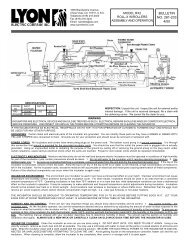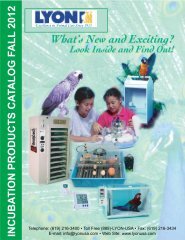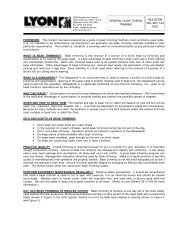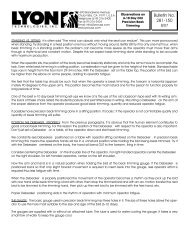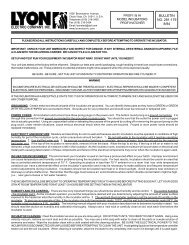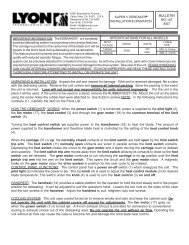a general guide to beak trimming game birds and duck debilling - Lyon
a general guide to beak trimming game birds and duck debilling - Lyon
a general guide to beak trimming game birds and duck debilling - Lyon
Create successful ePaper yourself
Turn your PDF publications into a flip-book with our unique Google optimized e-Paper software.
Bulletin 281-145 Page Two<br />
EFFECTS OF EXCESSIVE HEAT IN BEAK TRIMMING: The costliest error in <strong>beak</strong> <strong>trimming</strong> is the use of excessive<br />
or prolonged heat, especially when doing severe <strong>beak</strong> <strong>trimming</strong>. The heated blade is primarily used <strong>to</strong> cut<br />
the <strong>beak</strong> <strong>and</strong> sear the surface <strong>to</strong> s<strong>to</strong>p bleeding. The application of <strong>to</strong>o much heat may result in a ball like<br />
growth on the <strong>beak</strong> that is tender. This can be painful <strong>to</strong> the bird when eating <strong>and</strong> drinking <strong>and</strong> cause the<br />
bird's death. Never use more heat than necessary <strong>to</strong> do the job.<br />
ABOUT BLEEDERS: BLEEDING AFTER BEAK TRIMMING DOES NOT NECESSARILY MEAN BLADE<br />
TEMPERATURE WAS TOO LOW. Some <strong>birds</strong> naturally bleed as the result of trauma, however, some<br />
bleeding is better than unnecessary <strong>and</strong> excessive burning. There are other fac<strong>to</strong>rs that can cause bleeding.<br />
If the bird is under stress prior <strong>to</strong> <strong>beak</strong> <strong>trimming</strong> its blood pressure will be higher. Some avian medication will<br />
thin the blood <strong>and</strong> contribute <strong>to</strong> bleeding. It is a good idea <strong>to</strong> check with your veterinarian regarding this <strong>and</strong><br />
seek his advice relative <strong>to</strong> removal of medication for a period prior <strong>to</strong> <strong>beak</strong> <strong>trimming</strong>. Also, consider giving<br />
the <strong>birds</strong> vitamin K for a couple of days prior <strong>to</strong> <strong>beak</strong> <strong>trimming</strong> <strong>to</strong> reduce bleeding potential. Water intake<br />
could possibly raise blood pressure thus contributing <strong>to</strong> bleeding, do not allow the <strong>birds</strong> <strong>to</strong> drink water 1-2<br />
hours prior <strong>to</strong> <strong>beak</strong> <strong>trimming</strong>. Consultation with a good veterinarian is advised <strong>and</strong> the period of water restriction<br />
might vary for different species of <strong>birds</strong>.<br />
BEAK TRIMMING DAY-OLD QUAIL<br />
BEAK TRIMMING DAY-OLD QUAIL: This method of <strong>beak</strong> <strong>trimming</strong><br />
was developed by H.R. Wilson, M.G. Miller <strong>and</strong> C.R. Douglas at the<br />
Poultry Science Department, University of Florida whose permission<br />
<strong>to</strong> print this method is gratefully acknowledged. This method involves<br />
the use of a plain, slightly red hot flat blade on the De<strong>beak</strong>er® (K or<br />
KH Blade). The chick's head is held so that the <strong>to</strong>ngue will be pulled<br />
back in<strong>to</strong> the mouth. (Using the forefinger <strong>to</strong> apply a SLIGHT pressure<br />
<strong>to</strong> the throat helps, but not enough <strong>to</strong> cause the lower <strong>beak</strong> <strong>to</strong> be<br />
withdrawn.) The head is held level <strong>and</strong> the <strong>beak</strong> pointed squarely<br />
<strong>and</strong> directly at the blade. The <strong>beak</strong> is quickly <strong>to</strong>uched <strong>to</strong> the hot<br />
blade <strong>and</strong> burned so that most or all of the lighter colored tip of the<br />
upper <strong>beak</strong> is burned. Both <strong>beak</strong>s are seared approximately 1/4 of<br />
the <strong>beak</strong> length. If the egg <strong>to</strong>oth is present prior <strong>to</strong> <strong>trimming</strong>, only<br />
about .5mm of it will remain after this operation. This will result in a<br />
smaller amount of the lower <strong>beak</strong> being trimmed, with both <strong>beak</strong>s<br />
ending at the same length. If the <strong>beak</strong> is held <strong>to</strong> the blade <strong>to</strong>o long,<br />
blisters may occur; or the chick may in some cases breathe the hot<br />
super heated air around the blade causing respira<strong>to</strong>ry damage.<br />
Remember that a Quail chick has the capability of moving the upper<br />
<strong>beak</strong> <strong>to</strong> some extent <strong>and</strong> will pull it down resulting in a disproportionate<br />
burning of the lower <strong>beak</strong>. This method works well <strong>and</strong> results in a<br />
permanently shortened <strong>beak</strong> (this shortening will not be obvious <strong>to</strong><br />
the untrained eye). Observation throughout the bird's growth will<br />
illustrate how de<strong>beak</strong>ed <strong>birds</strong> look at all stages of growth.<br />
QUAIL UPPER BEAK REMOVAL<br />
QUAIL UPPER BEAK REMOVAL: This method uses the <strong>Lyon</strong> IR-Game<br />
Bird Attachment <strong>to</strong> remove a portion of the bird's upper <strong>beak</strong>. At 6<br />
weeks of age when the <strong>birds</strong> are moved <strong>to</strong> the grow-out pen, remove<br />
1/3 of the upper <strong>beak</strong>. If pecking is a problem at an earlier stage <strong>and</strong><br />
you do not wish <strong>to</strong> use the <strong>to</strong>uch-sear method described above, you<br />
can remove 1/16" (the upper bill hook) at an earlier date. The bird<br />
should be at least three weeks old before upper <strong>beak</strong> removal is<br />
accomplished. Prior <strong>to</strong> three weeks of age the <strong>beak</strong> will not be long<br />
enough <strong>to</strong> properly trim <strong>and</strong> cauterize. If the bird's <strong>beak</strong> is trimmed<br />
by this method <strong>to</strong>o early, <strong>beak</strong> regrowth will almost always require<br />
<strong>to</strong>uch up <strong>trimming</strong> later.





